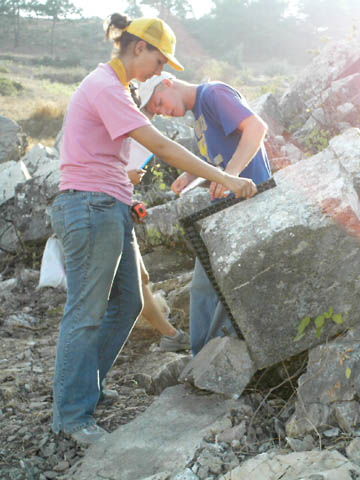| |
|
|

from the issue of September 20, 2007
|

| |
|
|
| |
Hoff, Erdogmus guide ancient rebuild in Turkey

Temple Project

BY SARA PIPHER, UNIVERSITY COMMUNICATIONS
As he sees it, Art History professor Michael Hoff has one of the best gigs in town.

| | 
 
| | | FIELD WORK - UNL students Mary Naughtin and Travis Schafter measure temple blocks at the Gazipasha temple site. The research is aimed at rebuilding the temple, which is remodeled in the image at top, right. Courtesy photos.

|
Never mind the days of hard labor clearing brush in 120-degree heat. Swallowing clouds of dust while hauling giant stones. Negotiating prickly local bureaucracies.

Hoff spends his summers exploring the ruins of a Roman temple in coastal Turkey. It's hot, dirty work, which Hoff likens to "playing in a sandbox."

"This is very different than walking through a museum or going through books in a library, which is something we all have to do," he said. "This is excavating a 2,000-year old building, looking for the secrets of the past."

Hoff has already devoted more than 11 years to his surveying work in Turkey. Each summer, he and his colleagues stayed in the town of Gazipasha, and over the years he has gotten to know locals and government officials. In 2004, he met with the town's mayor, and mentioned that he would be interested in going beyond surveying-he proposed excavating and re-erecting a temple that he had identified near the town. The mayor was enthusiastic about the idea, as was the regional governor.

In 2005, Hoff began mapping the temple site and drawing and cataloging of all of its stone blocks. That year Ece Erdogmus, a professor of architectural engineering at UNL, joined Hoff on the project. A native of Turkey, she brought not only academic expertise to the project, but also language skills and a familiarity with the country's government. In 2007, the team-in conjunction with a local archaeology museum - began moving the blocks from the mound.

The undertaking has been massive. The team began by clearing away overgrown vegetation. On past research trips, they had documented, surveyed, labeled and cataloged the surface of the site, and so this past summer they selected stones to move each day. Students cataloged the stones and made sketches of their surfaces, then the blocks were lifted with cranes and carried to an adjacent field.

The history of the temple is slowly revealing itself.

"We don't know yet to whom the temple was dedicated," Hoff said. "We know it was a Roman imperial temple, built specifically for the worship of a Roman emperor. It dates to the early third century after Christ. Our hope is that next year we'll find more information. For example, we'll be able to look at faces of blocks that are currently covered up. We hope to find some statuary under the rubble."
Back at UNL, work continues during the academic year. Hoff and Erdogmus synthesize data collected in the summer, and attempt to assemble drawings of the blocks like puzzle pieces.

"Mapping where the blocks fell will help us determine where they belonged originally," Hoff said. "Looking at the scatter of how they fell with sophisticated programs, we might be able to determine the cause of the temple's destruction. Right now think it was either an earthquake or purposeful destruction, probably at the hands of Christian extremists."

The researchers have funding for two more years from the National Science Foundation, but that is just for study of the site, Hoff said. After the initial investigation is completed, he will begin rebuilding the temple. In time, he also hopes to explore other parts of the site. The area is archaeologically rich, and he plans to "spend many, many more years there."

A significant component of the field research is the assistance of undergraduate students. In exchange for their hard work, they receive an education in art history and engineering that cannot be duplicated in a classroom.

"In classes, we talk about how to put a modern building together, but this is reversed; we are trying to figure out how and why this temple collapsed, and the students are actually at the building site trying to revive it," Erdogmus said. "For me, I am thinking this will happen only once in my life, and I think it's the same for the students."

"Our students are getting in on the ground floor of basic archaeological research," Hoff said. "This is hands-on experience with real construction and reconstruction methods and methodologies. I can't imagine a greater undergraduate experience than that."

See more photos of Hoff and Erdogmus' research into the Gazipasha temple online: www.unl.edu/ucomm/unltoday/popups/2007/turkey01.shtml
GO TO: ISSUE OF SEPTEMBER 20
NEWS HEADLINES FOR SEPTEMBER 20
Temple Project
Army officer to discuss his Afghanistan experience
Historic Nebraska newspapers to go digital
Multicultural Center progress report to be issued Sept. 26
NU general counsel to retire Dec. 31
Bringing life to environmental science
Event to mark University Libraries' three-millionth volume
OutSpeaking group to train, educate on LGBTQ concerns
Tool helps assess biofuel plant performance
732939S37290X
|
|
|
|
|
|
|
|